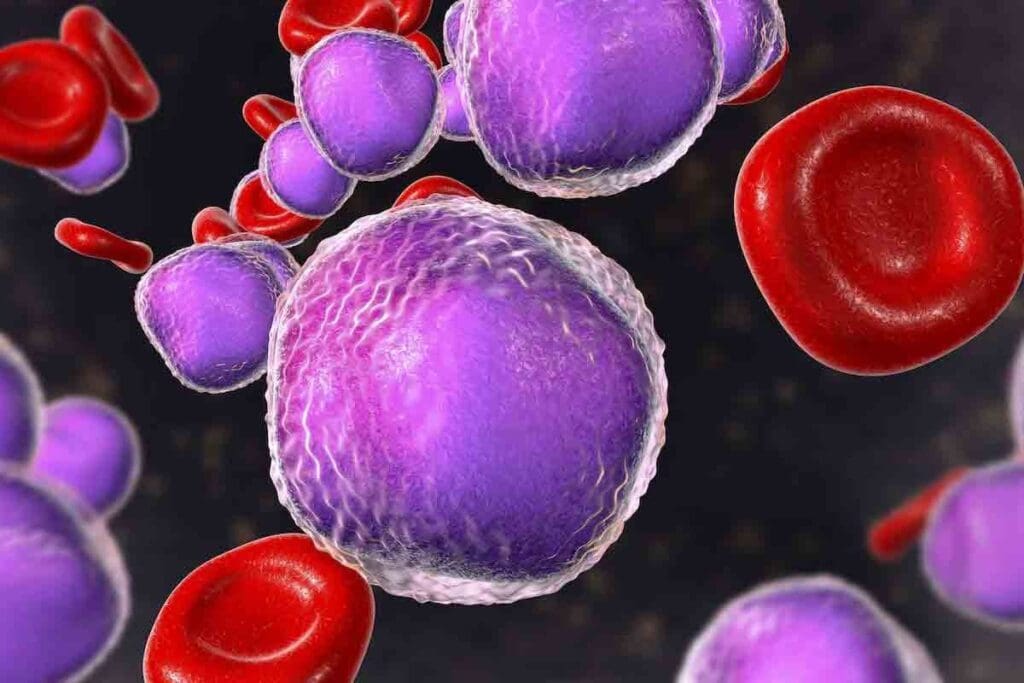Last Updated on November 20, 2025 by Ugurkan Demir

Childhood leukemia is the most common cancer in kids under 15. It’s important to understand its causes to find better ways to prevent and treat it. At Liv Hospital, we’re dedicated to finding the latest answers to this serious disease.
Leukemia is a cancer that affects the blood and bone marrow. It happens when young white blood cells grow too much. The reasons for childhood leukemia are complex, including genetics and exposure to radiation and chemicals. Knowing these factors helps us improve treatment and support for families.

Childhood cancer is a complex issue. It involves many factors that lead to its development. We will look at how genetic mutations are key in this process.
Childhood leukemia is a multifactorial disease. It is influenced by genetics, environment, and lifestyle. Genetic mutations in childhood leukemia are a major cause. These mutations can happen during rapid cell division, often before birth.
Most childhood leukemia cases come from spontaneous genetic mutations. These are not inherited. Research in the PMC shows these mutations can start in the womb. This shows how genetics and environment interact.
Blood cell development is tightly controlled. Leukemia disrupts this due to genetic mutations. The question of is childhood leukemia genetic is complex. It involves both inherited and acquired mutations.
Acute lymphoblastic leukemia (ALL) is the most common childhood leukemia. It is caused by uncontrolled lymphoblast growth. This growth is due to genetic changes that disrupt cell cycle control.
Children are more at risk for leukemia because of their fast growth and development. Rapid cell division raises the chance of genetic mutations. Also, their immune systems are not fully developed. This makes them more vulnerable to environmental stressors that could lead to leukemia.
Understanding these factors is key to finding ways to prevent and treat childhood leukemia.

Most childhood leukemia cases aren’t passed down from parents. But, some genetic conditions can raise the risk. It’s important to know the difference between inherited and acquired genetic changes.
Leukemia-causing genetic mutations can be inherited or acquired. Inherited mutations come from parents, while acquired ones happen during a person’s life. This can be due to environmental factors.
Key differences between inherited and acquired mutations:
Studies show most childhood leukemia comes from acquired mutations, not inherited ones. But, some genetic syndromes can greatly increase the risk.
Some genetic conditions make kids more likely to get leukemia. These include:
Kids with these syndromes need regular check-ups to catch leukemia early.
It’s key to understand the genetic factors behind childhood leukemia. While a genetic syndrome doesn’t mean a child will definitely get leukemia, it shows the need for careful monitoring and early action.
It’s important to know if leukemia can run in families. This helps us understand our risk and make better health choices. Leukemia might sometimes be linked to family history, but it’s not usually passed down through genes. We’ll look at how family history affects leukemia risk, the difference between inherited and random cases, and the role of genetic tests.
Having a relative with leukemia might slightly raise your risk. Research shows people with a family history of leukemia face a higher risk, but it’s not very high. The exact reasons for this increased risk are not fully understood, but genetics are thought to play a big part.
Some genetic syndromes, like Down syndrome, can increase leukemia risk. Certain genetic mutations, like those in the TP53 gene, can also raise the risk and might be passed down.
Most leukemia cases are not linked to family history. But, some families might see more cases of leukemia, hinting at a possible genetic link. It’s key to tell apart hereditary and random cases to understand causes and assess risk.
To tell the difference, researchers and doctors look for patterns in families. They check the type of leukemia, when it starts, and if there are other cancers. Genetic tests can also find specific mutations linked to higher leukemia risk.
Genetic tests can show an individual’s leukemia risk, which is helpful for those with a family history. But, genetic testing has its limits and ethical issues. It’s vital to understand its implications and get guidance from a healthcare professional.
For families with leukemia history, genetic counseling is key. Counselors help families grasp their risk, discuss genetic test benefits and limits, and make health choices.
Studies show that environmental factors play a big role in childhood leukemia. It’s key to know how different environmental factors can raise the risk.
Ionizing radiation is a known risk for childhood leukemia. High levels of radiation, like from nuclear accidents or some medical tests, can greatly increase the risk. Children exposed to ionizing radiation are more likely to get leukemia, mainly acute lymphoblastic leukemia (ALL).
Some chemicals and toxins can also raise the risk of childhood leukemia. Benzene, found in gasoline and industrial emissions, is a known carcinogen that can cause leukemia. Kids exposed to benzene through pollution or their parents’ jobs may face a higher risk.
Using certain household products and pesticides can increase the risk of childhood leukemia. Pesticides, like those used in homes and gardens, have been linked to a higher risk of leukemia in children. Cutting down on these products can help reduce the risk.
Parental smoking, mainly maternal smoking during pregnancy, is a risk factor for childhood leukemia. Exposure to tobacco smoke in the womb or early childhood may increase the risk of leukemia. Parents should know the risks of smoking and avoid exposing their kids to tobacco smoke.
Understanding these environmental triggers helps us take steps to lower the risk of childhood leukemia. While some exposures can’t be avoided, being aware and taking preventive measures can help protect kids from this disease.
Leukemia in infants is a complex issue. It’s influenced by genetics and the environment. Infant leukemia is different from the kind found in older kids. This difference affects how it’s diagnosed and treated.
Infant leukemia is diagnosed in the first year of life. It has unique features. One key feature is the MLL gene, which is important in leukemia development.
Studies show that infant leukemia starts in-utero, during fetal development. This is backed by the finding of leukemic cells in newborn blood spots. It shows the disease begins before birth.
This highlights the need to focus on maternal health and exposures during pregnancy.
The MLL gene is often rearranged in infant leukemia. This makes the disease more aggressive. These rearrangements can happen due to genetic errors during fetal development.
Maternal exposures during pregnancy, like smoking and certain chemicals, may raise the risk of infant leukemia. Knowing these risk factors is key to preventing the disease.
By looking into infant leukemia’s unique traits and how maternal exposures might play a role, we can understand its causes better. More research is needed to uncover how genetics and the environment interact in infant leukemia.
The infection hypothesis suggests a link between delayed infections and childhood leukemia. It proposes that early infections shape the immune system, affecting leukemia risk. This idea is based on how early infections might influence the immune system’s development.
The theory of delayed exposure to common infections is key. It says kids who miss out on early infections might face a higher leukemia risk. This could lead to an abnormal immune response, possibly triggering leukemia.
The population mixing theory is another part of the hypothesis. It suggests that mixing different populations can lead to unusual infections. These infections might trigger leukemia in those who are genetically prone.
The immune system plays a vital role in the infection hypothesis. A child’s immune system grows as they encounter infections. But, if this exposure is delayed or abnormal, it could affect leukemia risk.
Studies have found links between infections and leukemia in children. For instance, daycare attendance or early infections might lower leukemia risk. Some research also shows certain infections are linked to specific leukemia types.
Though the infection hypothesis is promising, more research is needed. By studying infections, immune system development, and genetics, we can better understand leukemia. This could lead to new ways to prevent and treat it.
Research has found several factors that might lead to leukemia in kids. These include what the mom does during pregnancy, what the parents do at work, and the baby’s and parents’ health at birth.
Studies have looked into how mom’s health and habits during pregnancy might affect leukemia risk in kids. Maternal smoking during pregnancy is a big concern. Tobacco smoke can harm the fetus’s cells.
Other things like maternal nutrition and infections during pregnancy are also being studied. While the evidence is not as clear, they might also play a role.
Jobs that expose parents to chemicals, radiation, or hazardous substances are being looked at. For example, jobs that use pesticides or solvents can expose kids to harmful substances.
Research shows that paternal exposure to chemicals before a child is born might also raise the risk. This shows the importance of looking at both mom’s and dad’s exposures.
Birth weight has been linked to leukemia risk in some studies. Kids with higher birth weights might have a slightly higher risk, but why is not fully understood.
Other birth factors like gestational age and congenital anomalies are also being studied. They might help us understand how leukemia starts before birth.
Research has also looked into how advanced parental age affects leukemia risk. Some studies suggest older parents, but not just moms, might have a higher risk. This could be because of genetic changes over time.
Knowing about these risk factors is key to lowering leukemia risk in kids. While some risks can’t be changed, being aware can help with better care and choices during pregnancy.
Many parents worry about what causes childhood leukemia. They often believe things that aren’t true. It’s important to clear up these myths to help families feel better.
Some think that what kids eat can cause leukemia. But, research doesn’t back this up. Eating well is good for everyone, but it’s not linked to leukemia.
Studies have looked at food and nutrients, but the results are mixed. For example, a study in the Journal of the National Cancer Institute found no link between what moms eat and leukemia in kids.
| Dietary Factor | Association with Childhood Leukemia |
| Maternal fruit consumption during pregnancy | No significant association |
| High intake of antioxidants | Inconclusive evidence |
| Consumption of processed meats | Limited evidence suggesting a possible link |
Some worry about the link between EMFs and leukemia in kids. Some studies suggest a possible link. But, the World Health Organization says the evidence is weak.
The International Agency for Research on Cancer says EMFs might be linked to cancer. But, more research is needed to know for sure.
Leukemia can have a genetic link, but most cases aren’t passed down. Some genetic syndromes, like Down syndrome, raise the risk. But, most leukemia cases don’t have a family history.
Scientists are working to understand what causes leukemia. They’re looking at genes and the environment.
Some parents worry vaccines might cause leukemia. But, many studies have shown this isn’t true. Vaccines are safe and help protect kids from serious diseases.
The Centers for Disease Control and Prevention and the World Health Organization agree. Vaccines don’t increase the risk of leukemia. They help keep kids healthy.
By knowing the truth, we can support families with leukemia better. We can work together to understand this complex disease.
There’s no surefire way to stop childhood leukemia, but we can lower the risk. This disease is complex, with many possible causes. Yet, by tackling known risk factors, we can lower the chance of it happening.
One key way to lower leukemia risk is to avoid harmful environmental factors. Ionizing radiation is a known risk, so we should limit our exposure. This means avoiding unnecessary X-rays and CT scans.
It’s also important to cut down on chemical toxins and pollutants. Use safe cleaners, avoid pesticides, and keep homes well-ventilated, where pollution is a problem.
Keeping a healthy pregnancy is key to possibly lowering leukemia risk. Pregnant women should not smoke or be around secondhand smoke. Maternal smoking during pregnancy increases leukemia risk in kids.
They should eat well and live healthily to help their baby’s immune system grow strong.
Helping a child’s immune system grow early might help prevent leukemia. Breastfeeding is good for babies and might lower leukemia risk. It’s also important to keep up with vaccinations to build a strong immune system.
Even with prevention, leukemia can happen. Early detection and good medical care are key. Parents should know the signs and talk to a doctor if worried.
Understanding childhood leukemia is key to better prevention and treatment. This disease is complex, influenced by genetics and environment. We must keep studying to find new ways to help.
Research is vital to improve treatment for childhood cancer. By learning more about genetic and environmental causes, we can find better ways to prevent and treat it. Future studies will focus on how genes and environment interact.
To tackle childhood leukemia, we need a complete approach. We must use insights from genetics, environmental science, and medicine together. This way, we can create more effective prevention and treatment plans. This will greatly improve the lives of children with this disease.
Childhood leukemia comes from a mix of genetic and environmental factors. This includes inherited genes, radiation, and chemicals.
Some cases of childhood leukemia are linked to genetic mutations. But not all cases are genetic. Certain genetic syndromes, like Down syndrome, can increase the risk.
Leukemia is not usually passed down from parents. But having a family history might slightly raise your risk. Some genetic syndromes can be inherited.
Risk factors include genetic syndromes, radiation, and chemical exposures. Prenatal and perinatal factors, like maternal smoking, also play a role.
Preventing leukemia is not guaranteed. But, reducing environmental exposures and supporting early immune development can help lower the risk.
No, vaccines are not linked to childhood leukemia.
Ionizing radiation, from medical imaging or nuclear accidents, can damage blood cell DNA. This increases leukemia risk.
Genetic testing can find mutations linked to leukemia risk. It’s not routine for all kids. It’s usually for those with a family history or specific syndromes.
While no prevention is guaranteed, healthy lifestyle choices can help. Avoiding smoking and harmful chemicals may reduce risk.
Infant leukemia often involves MLL gene rearrangements. Maternal exposures, like smoking, during pregnancy may influence it.
The link between electromagnetic fields and childhood leukemia is unclear. More research is needed to understand any relationship.
Healthy lifestyle practices support early immune development. This includes breastfeeding, a balanced diet, and avoiding infections and harmful substances.
Subscribe to our e-newsletter to stay informed about the latest innovations in the world of health and exclusive offers!